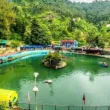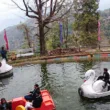If you’re looking for a peaceful escape from the hustle and bustle of city life, look no further than White Tank Mountain Regional Park. Located just west of Phoenix, Arizona, this stunning park offers visitors an array of outdoor activities and breathtaking views of the Sonoran Desert.
In this article, we’ll take a closer look at White Tank Mountain Regional Park, including its history, geography, flora and fauna, and the various recreational opportunities available to visitors. We’ll also provide some tips and recommendations for making the most of your visit.
History
The history of White Tank Mountain Regional Park can be traced back to the ancient Hohokam people, who lived in the area more than a thousand years ago. The Hohokam are known for their sophisticated irrigation systems, which allowed them to cultivate crops in the arid desert environment.
In the early 20th century, the land that is now White Tank Mountain Regional Park was used for ranching and mining. In the 1930s, the Civilian Conservation Corps (CCC) built a number of structures in the park, including picnic shelters and hiking trails. Today, many of these historic structures are still standing and can be seen throughout the park.
Geography
White Tank Mountain Park covers more than 30,000 acres of pristine Sonoran Desert. The park is named for the White Tank Mountains, a range of rugged peaks that rise to an elevation of more than 4,000 feet. The mountains are made up of a variety of rock formations, including granite, basalt, and sandstone.
The park is home to several natural springs, which provide a source of water for the local wildlife. Visitors can also see a variety of geological features, including canyons, washes, and rock formations.
Flora and Fauna
The Sonoran Desert is known for its incredible diversity of plant and animal life, and White Tank Mountain Park is no exception. Visitors to the park can expect to see a wide variety of cacti, including saguaro, cholla, and prickly pear. The park is also home to several species of trees, including palo verde, mesquite, and ironwood.
Wildlife in the park includes a variety of birds, such as quail, hawks, and owls, as well as desert reptiles like rattlesnakes, lizards, and Gila monsters. Visitors may also spot larger animals like javelina, coyotes, and bobcats.
Recreational Opportunities
White Tank Mountain Park offers visitors a wide range of recreational activities. Some of the most popular include:
Hiking: The park has more than 30 miles of hiking trails, ranging from easy strolls to challenging hikes up steep mountain slopes. Some of the most popular trails include the Waterfall Trail, which leads to a seasonal waterfall, and the Ford Canyon Trail, which offers stunning views of the surrounding mountains.
Camping: The park has several campgrounds, including the popular Desert Tortoise Campground, which offers stunning views of the desert landscape. Campsites include picnic tables, fire rings, and access to restroom facilities.
Picnicking: The park has several picnic areas, many of which are located near historic CCC structures. Visitors can enjoy a meal in the shade of a ramada while taking in the stunning desert scenery.
Horseback Riding: The park has several horse-friendly trails, allowing visitors to explore the park on horseback. Riders must bring their own horses, as the park does not offer horse rentals.
Mountain Biking: The park has several mountain biking trails, ranging from easy to difficult. Bikes are not available for rent in the park, so visitors must bring their own.
Stargazing: White Tank Mountain Regional Park is an excellent spot for stargazing, thanks to its remote location and lack of light pollution. Visitors can enjoy spectacular views of the night sky, including the Milky Way and other celestial objects.
Nature Programs: The park offers a variety of nature programs throughout the year, including guided hikes, wildlife viewing tours, and educational talks on the flora and fauna of the Sonoran Desert.
Tips for Visiting White Tank Mountain Regional Park
Before visiting White Tank Mountain Park, there are a few things to keep in mind:
- Dress appropriately: The desert can be hot during the day and cold at night, so it’s important to dress in layers and wear sunscreen and a hat.
- Bring plenty of water: The park recommends bringing at least one gallon of water per person per day.
- Stay on designated trails: To protect the fragile desert ecosystem, visitors are asked to stay on designated trails and avoid stepping on vegetation.
- Respect wildlife: Visitors should never approach or feed wildlife, and should keep a safe distance at all times.
- Be mindful of fire restrictions: During periods of high fire danger, the park may impose restrictions on campfires and other open flames.
Conclusion
White Tank Mountain Regional Park is a hidden gem in the Sonoran Desert, offering visitors a chance to experience the natural beauty and diversity of this unique ecosystem. With its stunning mountain vistas, diverse plant and animal life, and wide range of recreational opportunities, White Tank Mountain Park is a must-visit destination for anyone interested in exploring the great outdoors. Whether you’re hiking, camping, or just enjoying a picnic, the park offers something for everyone. So what are you waiting for? Plan your visit to White Tank Mountain Regional Park today!
Similar Articles
- Kofa National Wildlife Refuge: Discovering the Natural Wonders of Arizona
- 10 Best Day Trips from Sedona: Explore the Beauty of the Southwest
- Coconino National Forest: A Natural Wonderland in Northern Arizona
Frequently Asked Questions About White Tank Mountain Regional Park
Q: Where is White Tank Mountain Regional Park located?
A: White Tank Mountain Park is located in Maricopa County, Arizona, approximately 25 miles west of downtown Phoenix.
Q: What is the entrance fee for White Tank Mountain Regional Park?
A: The entrance fee for White Tank Mountain Park is $7 per vehicle for day use. Annual passes are also available.
Q: Are pets allowed in White Tank Mountain Regional Park?
A: Yes, pets are allowed in the park, but they must be kept on a leash at all times and are not allowed on some trails. Owners are also responsible for cleaning up after their pets.
Q: Can I camp in White Tank Mountain Park?
A: Yes, the park has several campgrounds, including the Desert Tortoise Campground, which offers both tent and RV camping.
Q: Are there guided hikes or nature programs available at White Tank Mountain Regional Park?
A: Yes, the park offers a variety of nature programs throughout the year, including guided hikes, wildlife viewing tours, and educational talks on the flora and fauna of the Sonoran Desert.
Q: What is the best time of year to visit White Tank Mountain Regional Park?
A: The best time to visit White Tank Mountain Park is during the fall, winter, and early spring when temperatures are mild and the weather is dry. Summer temperatures can be extremely hot, making outdoor activities uncomfortable and potentially dangerous.
Q: What activities can I do in White Tank Mountain Regional Park?
A: White Tank Mountain Park offers a wide range of recreational activities, including hiking, mountain biking, horseback riding, picnicking, camping, and stargazing.
Q: What is the best hiking trail in White Tank Mountain Regional Park?
A: The park has several hiking trails, each offering a unique experience. The Waterfall Trail is one of the most popular, offering a scenic hike to a seasonal waterfall. The Ford Canyon Trail is also a popular choice, offering a challenging hike with stunning views of the park.
Q: Is there a visitor center at White Tank Mountain Park?
A: Yes, the park has a visitor center with exhibits on the flora, fauna, and geology of the Sonoran Desert, as well as information on park activities and events.
Q: Can I bring my own firewood for camping?
A: No, the park prohibits visitors from bringing their own firewood to prevent the spread of pests and diseases. Firewood is available for purchase at the park.
Q: Are there any restrictions on drones or other unmanned aircraft in White Tank Mountain Regional Park?
A: Yes, the park prohibits the use of drones and other unmanned aircraft without a special use permit. Visitors should contact the park for more information on obtaining a permit.
Q: Are there any dangerous animals in White Tank Mountain Park?
A: While encounters with dangerous animals are rare, visitors should be aware that the park is home to a variety of wildlife, including rattlesnakes and mountain lions. Visitors should stay on designated trails and keep a safe distance from wildlife.









